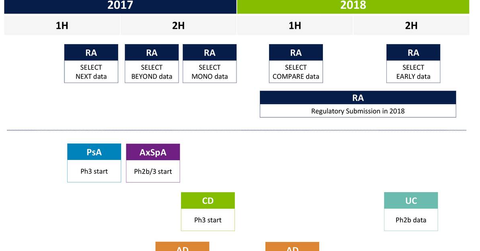Why Upadacitinib Could Drive AbbVie’s Long-term Growth
In September 2017, AbbVie (ABBV) presented the results from a phase 2B trial of upadacitinib (ABT-494) for the treatment of adult individuals with moderate to severe atopic dermatitis.
Oct. 25 2017, Published 2:43 p.m. ET

Upadacitinib for atopic dermatitis
In September 2017, AbbVie (ABBV) presented the results from a phase 2B trial of upadacitinib (ABT-494) for the treatment of adult individuals with moderate to severe atopic dermatitis that can’t be controlled by topical treatments or patients for whom topical treatments aren’t recommended.
Clinical trial outcomes
In the phase 2B trial, at week 16, patients receiving upadacitinib demonstrated statistically significant improvement compared to patients receiving placebo therapy. In the trial, 74%, 62%, and 39% were the mean percent changes from baselines in the EASI (eczema area and severity index) score for patients receiving upadacitinib 30 mg, 15 mg, and 7.5 mg, respectively, compared to 23% for patients on placebo therapy.
Further, 69%, 52%, and 29% of patients receiving 30 mg, 15 mg, and 7.5 mg, respectively, achieved 75% improvement in, or EASI 75, compared to 10% of patients on placebo. In the trial, 50%, 26%, and 14% of patients receiving the respective doses achieved EASI 90 compared to 2% for patients on placebo therapy. Further, as per measurements by the Investigator’s Global Assessment (or IGA) scale, 50%, 31%, and 14% of patients, respectively, achieved clear or almost clear skin compared to 2% of patients on placebo therapy.
Patients on upadacitinib also demonstrated statistically significant improvement to itch (pruritus). In the trial, 69%, 48%, and 40% of patients, respectively, demonstrated improved itch, measured by the pruritus numerical rating scale (or NRS), compared to 10% for patients receiving placebo therapy.
The Health Care Select Sector SPDR Fund (XLV) invests ~4.47% of its total portfolio holding in AbbVie.
